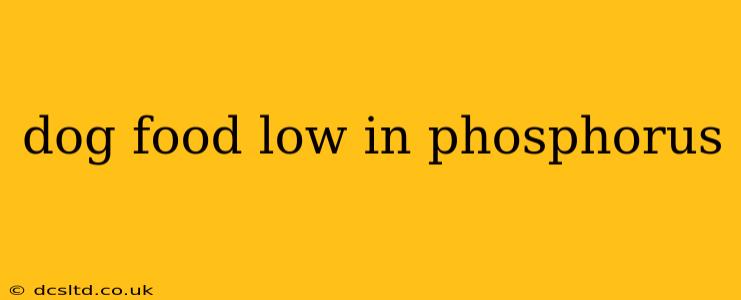Phosphorus is an essential mineral for dogs, playing a crucial role in bone health, energy production, and overall bodily functions. However, for dogs with certain health conditions, like kidney disease, a diet low in phosphorus is crucial. This comprehensive guide will explore the importance of low-phosphorus dog food, help you understand what to look for, and answer some frequently asked questions.
What is Phosphorus and Why is it Important for Dogs?
Phosphorus is a vital mineral involved in numerous bodily processes in dogs, including:
- Bone health: It's a key component of bones and teeth, contributing to their strength and structure.
- Energy production: Phosphorus works alongside other minerals to convert food into energy.
- Cell function: It's involved in various cellular processes, impacting overall health.
- Muscle function: Proper phosphorus levels contribute to normal muscle function.
- Nerve function: It's essential for healthy nerve transmission.
Why Would My Dog Need Low-Phosphorus Dog Food?
While phosphorus is essential, high levels can be detrimental to dogs with specific health problems, especially chronic kidney disease (CKD). Kidneys play a vital role in phosphorus regulation, and when they're not functioning optimally, phosphorus can build up in the bloodstream, leading to various complications. Other conditions that may necessitate a low-phosphorus diet include:
- Hyperparathyroidism: A disorder where the parathyroid glands produce excessive parathyroid hormone, leading to increased bone resorption and elevated phosphorus levels.
- Certain types of urinary tract stones: A low-phosphorus diet might be recommended in some cases to prevent the formation of certain types of stones.
Note: Always consult your veterinarian before switching your dog to a low-phosphorus diet. They can assess your dog's specific needs and recommend the appropriate food and dietary adjustments.
What to Look for in Low-Phosphorus Dog Food
When selecting low-phosphorus dog food, consider these factors:
- Phosphorus content: Look for foods explicitly labeled as "low phosphorus" or with a phosphorus content significantly lower than standard dog foods. The exact amount will vary depending on your dog's condition and veterinarian's recommendations.
- Ingredient list: Examine the ingredient list carefully. Foods with high protein content might not always have low phosphorus, as certain protein sources contain more phosphorus.
- Veterinary approval: Your veterinarian can recommend specific brands and types based on your dog's individual needs and health status.
What are the symptoms of high phosphorus in dogs?
Elevated phosphorus levels in dogs aren't always noticeable in the early stages. However, as levels continue to rise, symptoms may include:
- Loss of appetite: Your dog may show less interest in food or eat smaller portions.
- Lethargy: They may appear more tired and less active than usual.
- Weakness: Muscle weakness can develop as phosphorus imbalances affect muscle function.
- Kidney problems: As mentioned earlier, high phosphorus can exacerbate kidney issues.
- Bone pain: In some cases, high phosphorus may contribute to bone pain.
Can I make my own low-phosphorus dog food?
While it's possible to prepare homemade low-phosphorus meals for your dog, it's crucial to consult your veterinarian or a veterinary nutritionist. They can help you create a balanced diet that meets your dog's specific nutritional requirements while keeping phosphorus levels low. Incorrect homemade diets can lead to nutritional deficiencies.
Are there different types of low-phosphorus dog food?
Yes, various types are available, including:
- Dry kibble: Often the most convenient option.
- Wet food: Can be appealing to dogs with decreased appetite.
- Prescription diets: These are specially formulated to meet the specific needs of dogs with kidney disease or other conditions requiring low-phosphorus diets.
How often should I feed my dog low-phosphorus food?
The feeding frequency will depend on your dog's individual needs, as determined by your veterinarian. This might involve feeding smaller portions more often or sticking to a twice-daily feeding schedule. Always follow the feeding guidelines on the chosen dog food product.
This guide provides general information; always consult your veterinarian for personalized advice regarding your dog's dietary needs. They are the best resource for determining the appropriate low-phosphorus diet for your canine companion's health and well-being.
